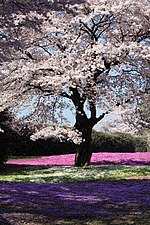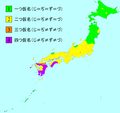The historical kana orthography (歴史的仮名遣い, rekishiteki kanazukai), or old orthography (旧仮名遣い, kyū kanazukai), refers to the kana orthography (正仮名遣い, sei...
25 KB (1,904 words) - 23:35, 19 October 2024
'true kana'), which were Chinese characters used phonetically to transcribe Japanese (e.g. man'yōgana); and hentaigana, which are historical variants...
31 KB (2,933 words) - 09:14, 4 October 2024
(えびす, 恵比須, 恵比寿, 夷, 戎), also transliterated Webisu (ゑびす, see historical kana orthography) or called Hiruko (蛭子) or Kotoshiro-nushi-no-kami (事代主神), is...
8 KB (933 words) - 23:09, 9 September 2024
Yōon (category Kana)
the yo kana, よ. Contrast this with kiyō, "skillful" (器用), which is written きよう [kijoo], with a full-sized yo kana. In historical kana orthography, yōon...
7 KB (371 words) - 12:10, 31 August 2024
between historical kana usage—which is also referred to as "old kana usage" (旧仮名遣, kyū kana-zukai)—and the modern kana orthography, called "modern kana usage"...
63 KB (6,222 words) - 06:34, 10 June 2024
William Adams (Japanese: ウィリアム・アダムス, Hepburn: Uwiriamu Adamusu, historical kana orthography: ウヰリアム・アダムス; 24 September 1564 – 16 May 1620), better known in...
74 KB (8,985 words) - 02:37, 27 October 2024
Inoue (kanji: 井上, historical kana orthography: ゐのうへ Winouhe) is the 16th most common Japanese surname. Historically, it was also romanized as Inouye,...
15 KB (1,772 words) - 14:11, 27 January 2024
Wabi-sabi Weltschmerz Sehnsucht Saudade Historical kana orthography: もののあはれ, modern kana: もののあわれ. The old kana form remains preferred in modern usage....
11 KB (1,157 words) - 13:44, 23 October 2024
Hiratsuka Raichō (平塚 らいちょう, transliterated らいてう according to the historical kana orthography; born Hiratsuka Haru, 平塚 明; February 10, 1886 – May 24, 1971)...
14 KB (1,571 words) - 11:27, 24 September 2024
the now-obsolete kana character we (ヱ or ゑ) for the even-older ye reading, an anachronism in keeping with historical kana orthography. This can lead to...
21 KB (1,891 words) - 14:10, 19 October 2024
for historical pronunciation and for orthographic purposes. In the 1946 orthographic reforms, を was largely replaced by お. In Japanese, this kana is used...
8 KB (520 words) - 14:43, 6 October 2024
Japanese) Full text (Kyūjitai and Historical kana orthography) at Aozora Bunko (in Japanese) Full text (Shinjitai and Modern kana usage) at Aozora Bunko (in...
6 KB (629 words) - 13:21, 3 November 2024
Philadelphia Vancouver Cherry Blossom Festival Historical kana orthography: もののあはれ, modern kana: もののあわれ. The old kana form remains preferred in modern usage....
77 KB (7,628 words) - 03:25, 23 October 2024
transliteration of the native Japanese アヅキ, as it was spelled according to historical kana orthography. The name is also transliterated as azuki, reflecting the modern...
21 KB (2,323 words) - 11:54, 2 November 2024
Shiranui (不知火, unknown fire, Shiranuhi in the historical kana orthography) is an atmospheric ghost light told about in Kyushu. They are said to appear...
10 KB (1,421 words) - 17:20, 9 November 2023
Japanese script reform (redirect from Orthographic reform in Japan)
1920s. In the 1900 kana usage reforms, hentaigana (old variant forms of kana) were eliminated, though historical kana orthography (dating to the Heian...
34 KB (4,474 words) - 17:45, 15 July 2024
matanamu (“await the emperor's pilgrimage”); by applying the historical kana orthography, matanamu would be pronounced matanan. Kamens, Edward; Kamens...
27 KB (2,807 words) - 21:20, 13 October 2024
modern Japanese orthography as part of a general orthographic reform. The system was further amended in 1986. There were no small kana in the pre-reform...
6 KB (562 words) - 19:11, 28 September 2024
periods. Along with the kana for we ('ゑ' in hiragana, 'ヱ' in katakana), this kana was deemed obsolete in Japanese with the orthographic reforms of 1946, to...
14 KB (1,288 words) - 14:20, 19 August 2024
Gojūon (category Kana)
"twisted sound"): kana digraphs, consisting of a 直音 and a small kana, such as きゃ or くゎ, although in historical kana orthography, small kana were simply 直音...
29 KB (2,544 words) - 10:34, 14 October 2024
Hull Grundy, "His netsuke [...] are extremely rare." In the historical kana orthography he was spelled "Kwanman" (くゎんまん). It can also be pronounced as...
3 KB (309 words) - 18:39, 15 October 2023
Girls". Normally written as 女子高生, the character 高 is written in historical kana orthography as かう. "タイトルの女子かう生ですが「かう」ってどこからきてると思いますか?". Yahoo! Japan (in...
12 KB (576 words) - 08:43, 9 June 2024
Katakana (redirect from ISO 15924:Kana)
"fragmentary kana", as the katakana characters are derived from components or fragments of more complex kanji. Katakana and hiragana are both kana systems...
55 KB (4,642 words) - 16:48, 30 October 2024
centuries from a highly phonemic to a largely morphophonemic orthography.[citation needed] Japanese kana are almost completely phonemic but have a few morphophonemic...
26 KB (3,319 words) - 05:58, 17 October 2024
and え, as relics of historical kana usage. Korean hangul and Tibetan scripts were also originally extremely shallow orthographies, but as a representation...
14 KB (1,683 words) - 18:00, 22 October 2024
yielded, regularly, -wa from -fa from -pa). This is noted with historical kana orthography in dictionaries; for example, 言う (iu) from 言ふ (ifu) from ipu...
129 KB (6,447 words) - 05:11, 16 September 2024
Hiragana (category Kana)
'to use') is spelled つかう in hiragana, so kanazukai (仮名遣い; 'kana use', or 'kana orthography') is spelled かなづかい in hiragana. However, there are cases where...
52 KB (4,207 words) - 23:52, 3 November 2024
spellings have been retained in modern English orthography, but the Great Vowel Shift and other historical sound changes mean that the modern pronunciations...
41 KB (4,358 words) - 13:56, 20 October 2024
using the Historical kana orthography. After the end of the War, the Kitōsho of 1959 became available, using post-war Japanese orthography, but still...
118 KB (15,446 words) - 23:01, 21 October 2024














